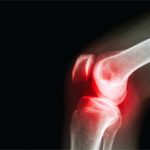NEW YORK (Reuters Health)—Interleukin (IL) 1 beta is a key player in the osteoarthritis (OA) inflammatory process and inhibiting it may help slow the disease process, according to an exploratory analysis of data from the CANTOS trial.1
CANTOS participants who were treated with the IL-1-beta inhibitor canakinumab had a significantly lower rate of total hip or total knee replacements over an average follow up of nearly four years.
This intriguing finding deserves further investigation in developing potential disease-modifying osteoarthritis drugs, write the authors of an editorial published with the study in Annals of Internal Medicine.2
CANTOS had shown that canakinumab (150 or 300 mg of subcutaneous canakinumab taken every three months for up to five years) significantly reduced cardiovascular events in patients with a history of myocardial infarction and elevated high-sensitivity C-reactive protein (hsCRP), with the greatest benefit in those with the most robust reductions in hs-CRP and IL-6.
“CANTOS therefore provided a unique opportunity to explore the effects of IL-1-targeted therapy versus placebo on incidence rates of total hip or total knee replacement surgeries,” notes Paul Ridker, MD, MPH, of Brigham and Women’s Hospital and Harvard Medical School in Boston and colleagues.
The osteoarthritis data from the trial, they now report, show that with a median follow-up of 3.7 years, the combined incidence rates of total hip or knee replacement were 40% to 47% lower with canakinumab than placebo.
The hazard ratios (HRs) were 0.60 (95% confidence interval (CI), 0.38 to 0.95) with 50 mg canakinumab, 0.53 (95% CI, 0.33 to 0.84) for the 150 mg group and 0.60 (95% CI, 0.38 to 0.93) for the 300 mg group.
In the pooled canakinumab groups, compared with the placebo group, incidence rates for total hip or total knee replacement were 0.31 and 0.54 events per 100 person-years, respectively (HR: 0.58; 95% CI, 0.42 to 0.80).
The apparent protective effect of canakinumab on total hip or total knee replacement surgeries was evident after only one year of treatment. The benefit of canakinumab remained statistically significant when patients with a history of crystalline or inflammatory arthritis were excluded.
Treatment with canakinumab was also associated with fewer OA-related symptoms during follow up.
However, the authors caution that the number of women in the trial was relatively low, which is a concern given that knee OA largely affects older women.
Editorialists Nancy Lane, MD, of UC Davis Health in Sacramento, Calif., and David Felson, MD, MPH, of Boston University School of Medicine say the results of this exploratory analysis are “both unexpected and exciting” and using elevated hsCRP level as an entry criterion is a novel aspect of the trial design.
“This requirement, not routine in osteoarthritis trials, may have identified a subgroup of persons with osteoarthritis in whom inflammatory cytokines activate pathways that accelerate joint degeneration,” they write.
They note that based on current understanding of OA pathophysiology, IL-1 is a key player in both cartilage degradation and the enhancement of joint pain and these results “may offer promise for IL-1 inhibition as a treatment.”
“Further studies should evaluate the importance of elevated CRP levels as a factor affecting response to treatment, include more women to better reflect the osteoarthritis population, explore how to minimize infections, and try to better define the duration of therapy needed to detect treatment effects,” Drs. Lane and Felson conclude.
The CANTOS trial was supported by Novartis Pharmaceuticals. Dr. Ridker and several coauthors have disclosed financial relationships with the company.
References
- Schieker M, Conaghan PG, Mindeholm L, et al. Effects of interleukin 1β inhibition on incident hip and knee replacement: Exploratory analyses from a randomized, double-blind, placebo-controlled trial. Ann Intern Med. 2020 Aug 4. Online ahead of print.
- Lane N, Felson D. A promising treatment for osteoarthritis? Ann Intern Med. 2020 Aug 4. Online ahead of print.

